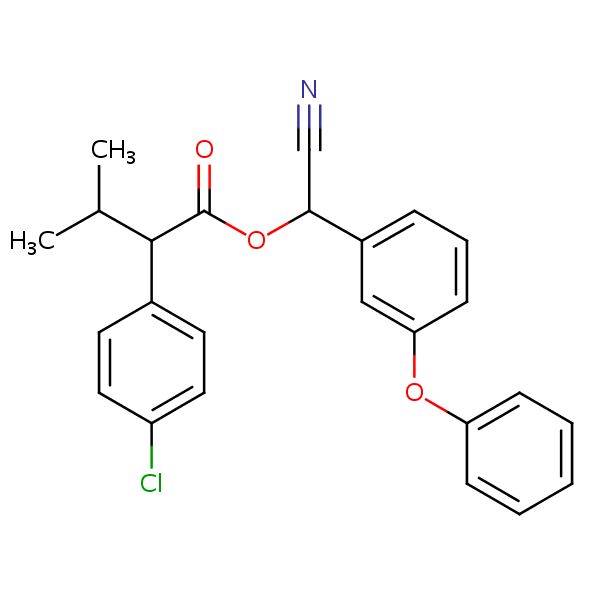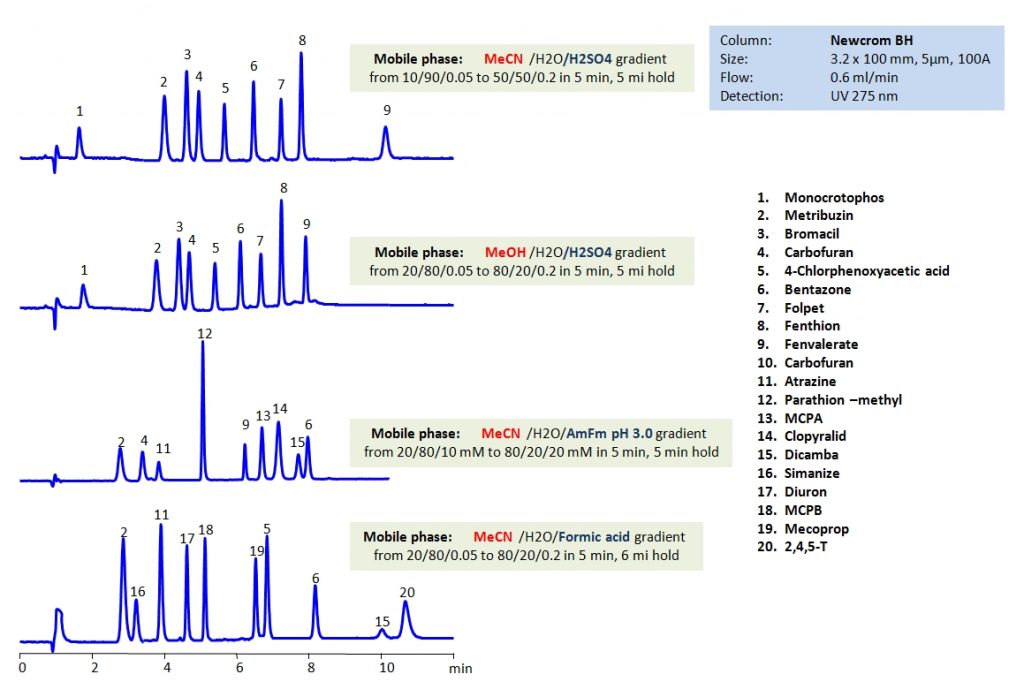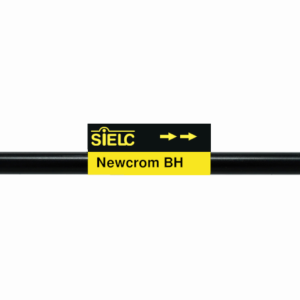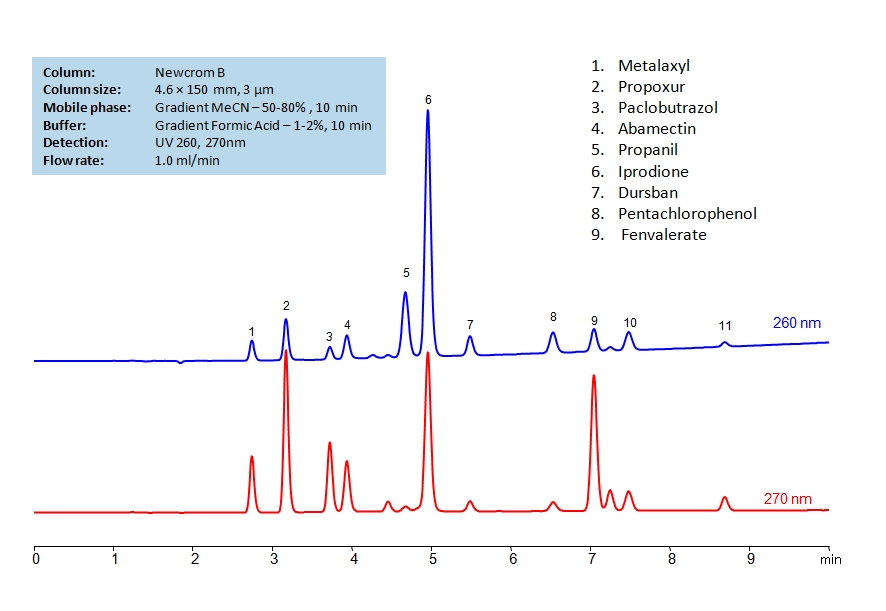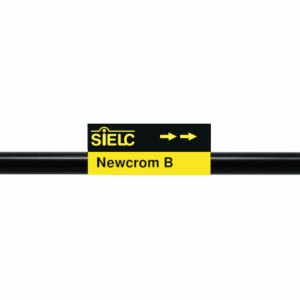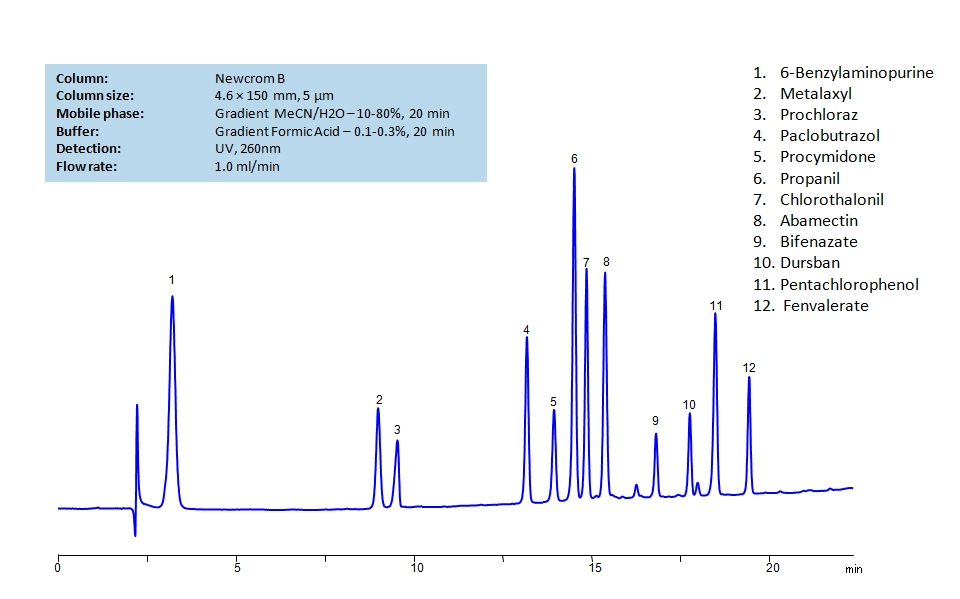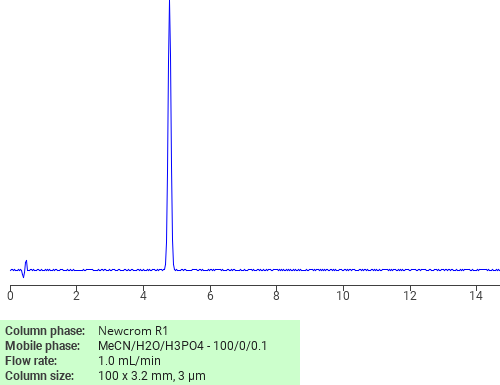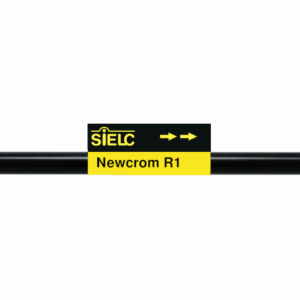| CAS Number | 51630-58-1 |
|---|---|
| Molecular Formula | C25H22ClNO3 |
| Molecular Weight | 419.911 |
| InChI Key | NYPJDWWKZLNGGM-UHFFFAOYSA-N |
| LogP | 6.20 |
| Synonyms |
|
Applications:
HPLC Separation of Pesticides, Herbicides, Fungicides, and Insecticides on Newcrom BH Column
May 22, 2020
HPLC Method for Mecoprop, MCPB, Diuron, Simazine, Dicamba, Clopyralid, MCPA, Atrazine, Carbofuran, Fenvalerate, Folpet, Bentazone-sodium, 2,4,5-Trichlorophenoxyacetic acid, 4-CPA, Methyl parathion, Metribuzin, Monocrotophos on Newcrom BH by SIELC Technologies
High Performance Liquid Chromatography (HPLC) Method for Analysis of Mecoprop, MCPB, Diuron, Simazine, Dicamba, Clopyralid, MCPA, Atrazine, Carbofuran, Fenvalerate, Folpet, Bentazone-sodium, 2,4,5-Trichlorophenoxyacetic acid, 4-CPA, Methyl parathion, Metribuzin, Monocrotophos.
Herbicides are used to control unwanted plants, they are also known as weedkillers. Insecticides are used to kill insects. Fungicides are used to kill parasitic fungi. Pesticide is a more generic term that includes herbicides, fungicides and insecticides in its definition. All are heavily used in agriculture.
By using HPLC, many different pesticides can be separated and their retention characteristics controlled using the Newcrom BH mixed-mode column. It can be used with different organic media such as acetonitrile (ACN) or methanol (MeOH). By varying the concentration of organic modifier and using different buffers like sulfuric acid (H2SO4), ammonium formate (AmFm), or formic acid, separation of desired pesticides can be achieved.
| Column | Newcrom BH, 3.2 x 100 mm, 5 µm, 100 A, dual ended |
| Mobile Phase | MeCN, MeOH |
| Buffer | H2SO4, Formic acid, AmFm pH 3.0 |
| Flow Rate | 0.6 ml/min |
| Detection | UV 275 nm |
| Class of Compounds | Pesticides, Herbicides, Fungicides, Insecticides |
| Analyzing Compounds | Mecoprop, MCPB, Diuron, Simazine, Dicamba, Clopyralid, MCPA, Atrazine, Carbofuran, Fenvalerate, Folpet, Bentazone-sodium, 2,4,5-Trichlorophenoxyacetic acid, 4-CPA, Methyl parathion, Metribuzin, Monocrotophos |
Application Column
Newcrom BH
Column Diameter: 3.2 mm
Column Length: 100 mm
Particle Size: 5 µm
Pore Size: 100 A
Column options: dual ended
4-CPA
Atrazine
Bentazone-sodium
Carbofuran
Clopyralid
Dicamba
Diuron
Fenvalerate
Folpet
MCPA
MCPB
Mecoprop
Methyl parathion
Metribuzin
Monocrotophos
Simazine

HPLC Separation of Pesticides on Newcrom B Column
February 3, 2020
HPLC Method for Metalaxyl (UV), Propoxur, Paclobutrazol, Abamectin, Propanil, Iprodione, Chlorpyrifos-methyl (Dursban), Pentachlorophenol, Fenvalerate on Newcrom B by SIELC Technologies
High Performance Liquid Chromatography (HPLC) Method for Analysis of Metalaxyl (UV), Propoxur, Paclobutrazol, Abamectin, Propanil, Iprodione, Chlorpyrifos-methyl (Dursban), Pentachlorophenol, Fenvalerate.
Metalaxyl, also known as methyl N-(methoxyacetyl)-N-(2,6-xylyl)-DL-alaninate, is a systemic fungicide with the chemical formula C15H21NO4. It is used to control Pythium and Phytophthora in vegetables. It has suffered a resistance problem going back to the 1980s.
Propoxur is a non-systemic insecticide produced from catechol with the chemical formula C11H15NO3. It has a variety of uses from turf, forestry, and agricultural pests to household pests and fleas.
Paclobutrazol (PBZ) is a synthetic triazole compound with the chemical formula C15H20ClN3O. It is used to control plant growth as an antagonist of the plant hormone gibberellin. Through reducing reducing internodal growth, it causes stronger stems, greater root growth, and earlier fruitset. It can also reduce frost sensitivity in plants.
Abamectin is a insecticide with the chemical formulas C48H72O14 and C47H70O14. It is also used to control fire ant populations. In veterinary cases, it is used to deworm horses as well as an antihelmintic.
Propanil is a contact herbicide with the chemical formula C9H9Cl2NO. It is one of the most widely used herbicides in America. It works as an inhibitor of photosynthesis and CO2 fixation in weeds.
Iprodione is a hydantoin fungicide and nematicide with the chemical formula C13H13Cl2N3O3. It is used on a wide variety of crops that are affected by fungal diseases such as botrytis bunch rot, brown rot, and Sclerotinia. Approval of using it is different across the world.
Dursban is a highly toxic organophosphate with the chemical formula C9H11Cl3NO3PS. It works through interrupting the electrochemical processes in nerves. This leads to a build-up of acetylcholine, which leads to paralysis and eventual death.
Pentachlorophenol is a manufactured chemical with the chemical formula C6HCl5O. It is most often used as herbicide, insecticide, fungicide, algaecide, and disinfectant. Exposure to it can cause damage to liver, kidney, blood, lungs, eyes, skin, and mouth. It is classified as a probable human carcinogen.
Fenvalerate is synthetic pyrethroid insecticide with the chemical formula C25H22ClNO3. It is used against a wide range of pests, partially due to it’s moderate mammalian toxicity following short-term and acute exposure. It is the most toxic to bees and fish. Upon contact, it may irritate skin and eyes.
Metalaxyl (UV), Propoxur, Paclobutrazol, Abamectin, Propanil, Iprodione, Chlorpyrifos-methyl (Dursban), Pentachlorophenol, Fenvalerate can be retained and analyzed using the Newcrom B stationary phase column. The analysis utilizes an isocratic method with a simple mobile phase consisting of water and acetonitrile (MeCN) with a formic acid buffer. Detection is performed using UV.
| Column | Newcrom B, 4.6 x 150 mm, 3 µm, 100 A, dual ended |
| Mobile Phase | MeCN/H2O |
| Buffer | Formic Acid |
| Flow Rate | 1.0 ml/min |
| Detection | UV, 260, 270 nm |
| Class of Compounds | Hydrophobic, Herbicide, Pesticide |
| Analyzing Compounds | Metalaxyl (UV), Propoxur, Paclobutrazol, Abamectin, Propanil, Iprodione, Chlorpyrifos-methyl (Dursban), Pentachlorophenol, Fenvalerate |
Application Column
Newcrom B
Column Diameter: 4.6 mm
Column Length: 150 mm
Particle Size: 3 µm
Pore Size: 100 A
Column options: dual ended
Chlorpyrifos-methyl (Dursban)
Fenvalerate
Iprodione
Metalaxyl (UV)
Paclobutrazol
Pentachlorophenol
Propanil
Propoxur

HPLC Separation of 12 Pesticides on Newcrom B Column
January 24, 2020
HPLC Method for 6-Benzylaminopurine, Metalaxyl (UV), Prochloraz, Paclobutrazol, Propanil, Chlorothalonil, Chlorpyrifos-methyl (Dursban), Pentachlorophenol, Fenvalerate, Abamectin, Procymidone, Bifenazate on Newcrom B by SIELC Technologies
High Performance Liquid Chromatography (HPLC) Method for Analysis of 6-Benzylaminopurine, Metalaxyl (UV), Prochloraz, Paclobutrazol, Propanil, Chlorothalonil, Chlorpyrifos-methyl (Dursban), Pentachlorophenol, Fenvalerate, Abamectin, Procymidone, Bifenazate.
6-Benzylaminopurine is a plant growth regulation compound with the molecular formula C12H11N5. It’s presence in asparagus, for example, leads to deeper color, increased firmness, and a decrease in fibrous hardness. In general, it stimulates cell division and differentiation.
Metalaxyl, also known as methyl N-(methoxyacetyl)-N-(2,6-xylyl)-DL-alaninate, is a systemic fungicide with the chemical formula C15H21NO4. It is used to control Pythium and Phytophthora in vegetables. It has suffered a resistance problem going back to the 1980s.
Prochloraz is an imidazole fungicide with the chemical formula C15H16Cl3N3O2. It is used widely across Europe, Asia, South America, and Australia, but is not registered for use in the United States. It works as an inhibitor of the enzyme lanosterol 14α-demethylase.
Paclobutrazol (PBZ) is a synthetic triazole compound with the chemical formula C15H20ClN3O. It is used to control plant growth as an antagonist of the plant hormone gibberellin. Through reducing reducing internodal growth, it causes stronger stems, greater root growth, and earlier fruitset. It can also reduce frost sensitivity in plants.
Procymidone is a pesticide and fungicide with the chemical formula C13H11Cl2NO2. It is typically used to kill unwanted ferns, nettles, and fungi in lupins, grapes, stone fruit, and strawberries.
Propanil is a contact herbicide with the chemical formula C9H9Cl2NO. It is one of the most widely used herbicides in America. It works as an inhibitor of photosynthesis and CO2 fixation in weeds.
Chlorothalonil is a compound with a variety of uses as a fungicide, wood protectant, pesticide, and acaricide. It is used predominantly on peanuts, potatoes, and tomatoes. Outside of agriculture, it is also used in paints, resins, emulsions, and coatings. It’s chemical formula is C8Cl4N2.
Abamectin is a insecticide with the chemical formulas C48H72O14 and C47H70O14. It is also used to control fire ant populations. In veterinary cases, it is used to deworm horses as well as an antihelmintic.
Bifenazate is pesticide with the chemical formula C17H20N2O3. It is typically used to control a large variety of mite pests in plants in various settings. It works through modulating GABA receptors and inhibiting complex III of the mitochondrial electron transport chain.
Dursban is a highly toxic organophosphate with the chemical formula C9H11Cl3NO3PS. It works through interrupting the electrochemical processes in nerves. This leads to a build-up of acetylcholine, which leads to paralysis and eventual death.
Pentachlorophenol is a manufactured chemical with the chemical formula C6HCl5O. It is most often used as herbicide, insecticide, fungicide, algaecide, and disinfectant. Exposure to it can cause damage to liver, kidney, blood, lungs, eyes, skin, and mouth. It is classified as a probable human carcinogen.
Fenvalerate is synthetic pyrethroid insecticide with the chemical formula C25H22ClNO3. It is used against a wide range of pests, partially due to it’s moderate mammalian toxicity following short-term and acute exposure. It is the most toxic to bees and fish. Upon contact, it may irritate skin and eyes.
6-Benzylaminopurine, Metalaxyl (UV), Prochloraz, Paclobutrazol, Propanil, Chlorothalonil, Chlorpyrifos-methyl (Dursban), Pentachlorophenol, Fenvalerate, Abamectin, Procymidone, Bifenazate can be retained and analyzed using the Newcrom B stationary phase column. The analysis utilizes an isocratic method with a simple mobile phase consisting of water and acetonitrile (MeCN) with a formic acid buffer. Detection is performed using UV.
| Column | Newcrom B, 4.6 x 150 mm, 5 µm, 100 A, dual ended |
| Mobile Phase | MeCN/H2O |
| Buffer | Formic Acid |
| Flow Rate | 1.0 ml/min |
| Detection | UV, 260 nm |
| Class of Compounds | Hydrophobic, Herbicide, Pesticide |
| Analyzing Compounds | 6-Benzylaminopurine, Metalaxyl (UV), Prochloraz, Paclobutrazol, Propanil, Chlorothalonil, Chlorpyrifos-methyl (Dursban), Pentachlorophenol, Fenvalerate, Abamectin, Procymidone, Bifenazate |
Application Column
Newcrom B
Column Diameter: 4.6 mm
Column Length: 150 mm
Particle Size: 5 µm
Pore Size: 100 A
Column options: dual ended
Abamectin
Bifenazate
Chlorothalonil
Chlorpyrifos-methyl (Dursban)
Fenvalerate
Metalaxyl (UV)
Paclobutrazol
Pentachlorophenol
Prochloraz
Procymidone
Propanil

Separation of Fenvalerate on Newcrom R1 HPLC column
February 16, 2018
Fenvalerate can be analyzed by this reverse phase (RP) HPLC method with simple conditions. The mobile phase contains an acetonitrile (MeCN), water, and phosphoric acid. For Mass-Spec (MS) compatible applications the phosphoric acid needs to be replaced with formic acid. Smaller 3 µm particles columns available for fast UPLC applications. This liquid chromatography method is scalable and can be used for isolation impurities in preparative separation. It also suitable for pharmacokinetics.
Application Column
Newcrom R1
The Newcrom columns are a family of reverse-phase-based columns. Newcrom A, AH, B, and BH are all mixed-mode columns with either positive or negative ion-pairing groups attached to either short (25 Å) or long (100 Å) ligand chains. Newcrom R1 is a special reverse-phase column with low silanol activity.
Select options
